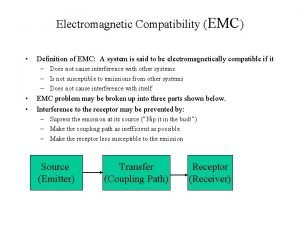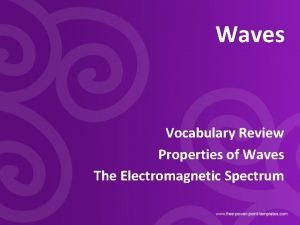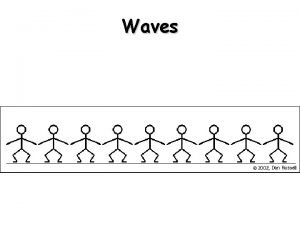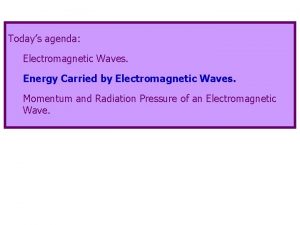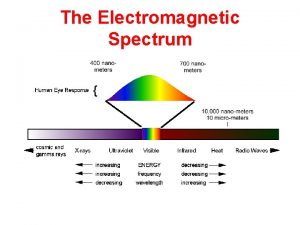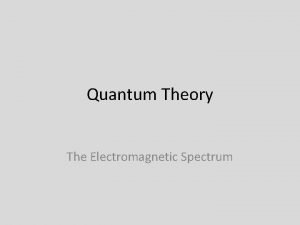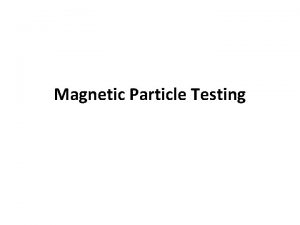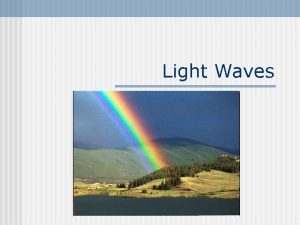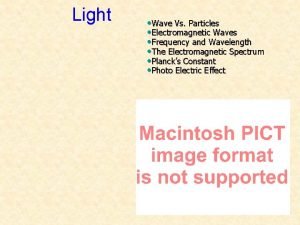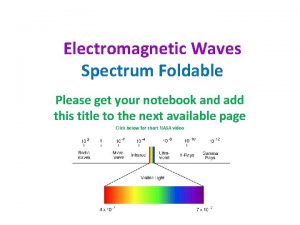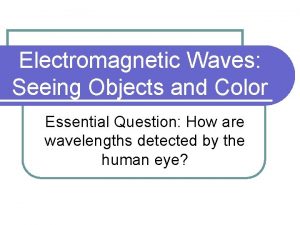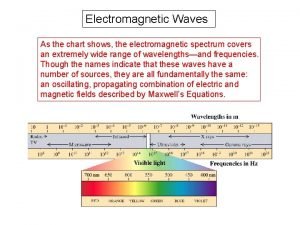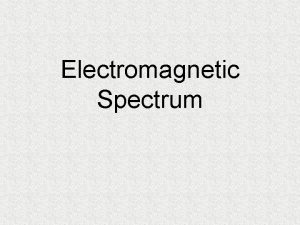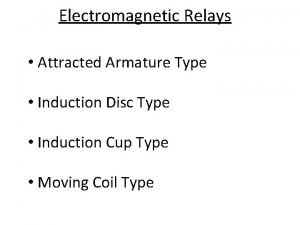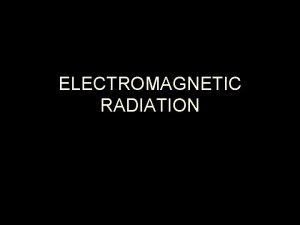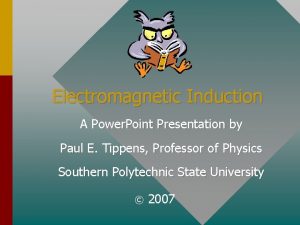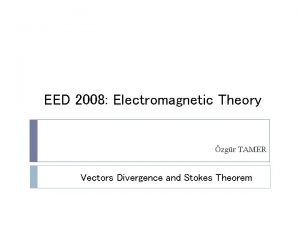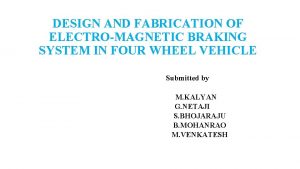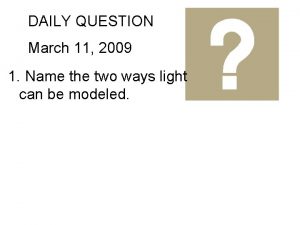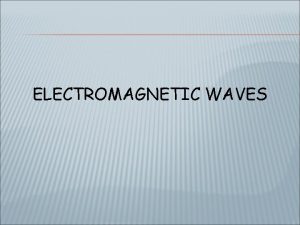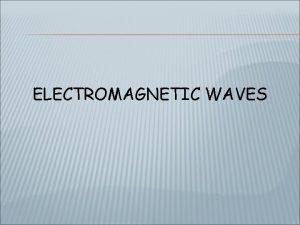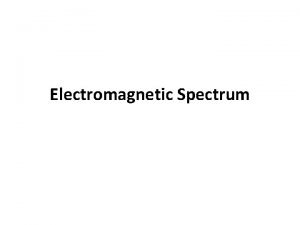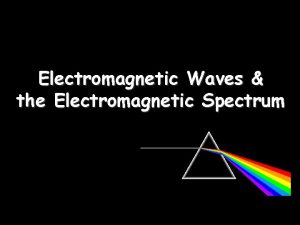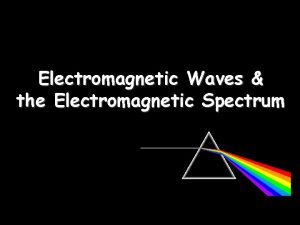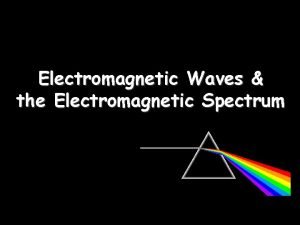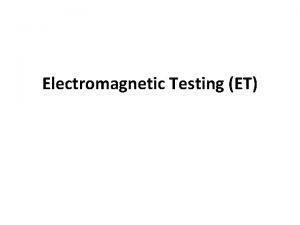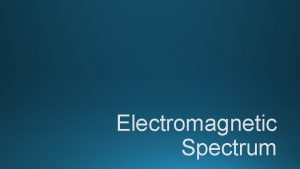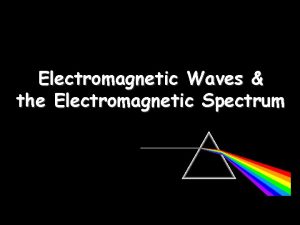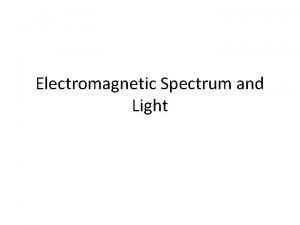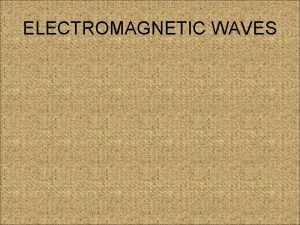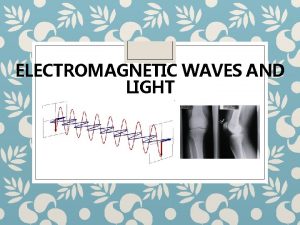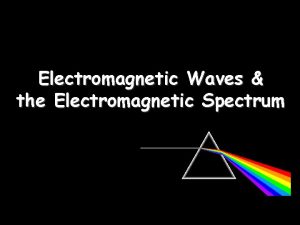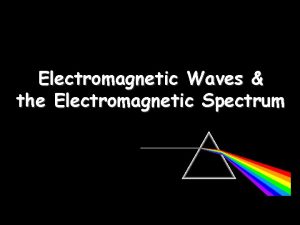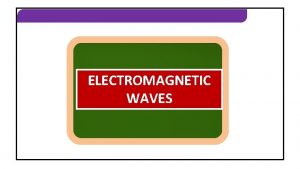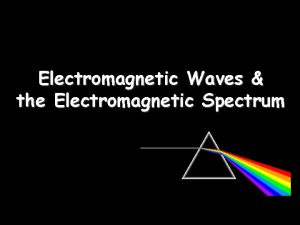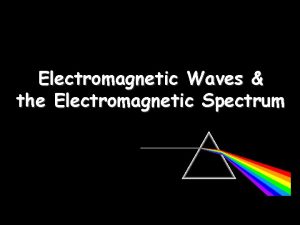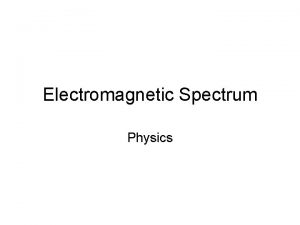Electromagnetic Principles Definition Electromagnetic is made up of
































- Slides: 32

Electromagnetic Principles

Definition Electromagnetic is made up of two words. 1. Electro, which has something to do with electricity and 2. magnetic, which has something do with magnetism.

Definition So, electromagnetic principles deal with the relationship between electricity and magnetism, as well as the relationship between magnetism and electricity.

There are two electromagnetic principles that we are going to review.

Principle # 1 The first principle that we want to review states that electrons will flow in a conductor when the conductor MOVES or PASSES through a magnetic field.

If it were not for this principle, we would not have ‘electricity’ today. Let’s take a closer look at this principle.

Generating Current Magnet NORTH Passing a conductor between two magnets and the magnetic field causes electrons to flow in the wire. This produces electrical current in the wire. SOUTH Magnet Conductor © 2005 Refrigeration Training Services - E 1#2 AC and DC Current v 1. 2

Alternating Current Magnet NORTH 0º 90º 180º 270º Positive Negative SOUTH Magnet One cycle Conductor © 2005 Refrigeration Training Services - E 1#2 AC and DC Current v 1. 2 8 360º

Effective voltage • Alternating current starts at 0, reaches a peak, then returns to 0 • Peak voltage at 90° (electrical degrees) • Effective voltage is. 707 times peak voltage © 2005 Refrigeration Training Services - E 1#2 AC and DC Current v 1. 2 9

Effective Voltage 0º 90º 180º Peak Voltage 170 v Effective Voltage 120 v. 707 x 170 = 120 v 0 v Effective voltage =. 707 x Peak voltage Note: Meters measure effective voltage © 2005 Refrigeration Training Services - E 1#2 AC and DC Current v 1. 2 10

Effective Voltage 0º 90º 180º Peak Voltage 340 v Effective Voltage 240 v. 707 x 340 = 240 v 0 v Effective voltage =. 707 x Peak voltage Note: Meters measure effective voltage © 2005 Refrigeration Training Services - E 1#2 AC and DC Current v 1. 2 11

The ‘effective voltage’ is also known as the RMS (Root Mean Square) value or the DC (Direct Current) equivalent.

Many years ago, there was only Direct Current. invented yet. AC was not But when it was, what do you think the reference current would be?

If you said DC, you would be correct. So, 120 v AC will do the same ‘work’ that 120 DC will do.

In other words, if you plug a 100 w incandescent light bulb into 120 v AC, it will glow just as bright as if you plugged it into 120 v DC, thus the DC equivalent.

For another example, if you wired a 240 v AC electric hot water tank to 240 v DC, it will heat the water just as quickly. equivalent. Thus, the DC

Generating Alternating Current (AC) • Passing a conductor through a magnetic field • A generator uses many conductors and a large magnetic field to produce electrical current © 2005 Refrigeration Training Services - E 1#2 AC and DC Current v 1. 2 17

Expressing AC with a Sine Wave • A sine wave shows how alternating current flows in one direction, then reverses to flow in the opposite direction. • A sine wave is a mathematical derivation of the trigonometric function – sine. You do not need to know trig. in order to understand AC though. © 2005 Refrigeration Training Services - E 1#2 AC and DC Current v 1. 2 18

Sine Wave of Alternating Current Magnet NORTH 0º 90º 180º 270º Positive Negative SOUTH Magnet One cycle Conductor © 2005 Refrigeration Training Services - E 1#2 AC and DC Current v 1. 2 19 360º

Cycles and Frequency • Cycle: – One complete electrical alternation • Frequency – Number of cycles in a second • Measurement of frequency: – Hertz (Hz) – Cycles • U. S. frequency is 60 hertz, or 60 cycles © 2005 Refrigeration Training Services - E 1#2 AC and DC Current v 1. 2 20

Principle # 2 The second principle that we want to review states that a magnetic field will be produced when electrons flow in a conductor.

If it were not for this principle, we would not have motors, relays, contactors, solenoids, timers, etc. Let’s take a closer look at this principle.

For the first example, let’s take a look at how electricity produces a magnetic field and is used on a device known as a ‘solenoid valve. ’

Solenoid Valve Magnetic coil energized Plunger pulled up Power off Plunger drops Fluid flows Plunger Fluid stops Seat © 2005 Refrigeration Training Services - E 1#4 Symbols and Wiring Diagrams v 1. 2 24

For the second example, let’s take a look at how electricity produces a magnetic field and is used on a device known as a ‘contactor. ’

Side View LINE L 1 L 2 T 1 T 2 CONTROL CIRCUIT LOAD © 2005 Refrigeration Training Services - E 2#3 Contactors and Motor Starters v 1. 2 26

Side View LINE Power to L 2 Contactor L 1 CONTROL CIRCUIT Magnetic Coil energized Contacts pulled in Power to T 2 Load T 1 LOAD © 2005 Refrigeration Training Services - E 2#3 Contactors and Motor Starters v 1. 2 27

For the third example, let’s take a look at how electricity produces a magnetic field and is used on a device known as a ‘motor. ’

Two-pole stator motor Stator Rotor (Stationary) (Rotates) Polarity reverses (N to S) on stator SN N S + _ © 2005 Refrigeration Training Services - E 2#1 Fan Motors v 1. 2 N S Stator repels & attracts rotor into motion When stator is energized the rotor will make a half turn with each half of current cycle 29

Second half of cycle N S Stator continues motion by repelling and attracting SN + _ © 2005 Refrigeration Training Services - E 2#1 Fan Motors v 1. 2 S N Polarity reverses (N to S) on stator The alternating current now changes direction 30

In conclusion, if it were not for electromagnetic principles, we would be living in the dark ages.

The End
 Electromagnetic compatibility definition
Electromagnetic compatibility definition Electromagnetic force definition
Electromagnetic force definition Spectrul electromagnetic
Spectrul electromagnetic Well made play
Well made play Electromagnetic waves vocabulary
Electromagnetic waves vocabulary Difference between electromagnetic and mechanical waves
Difference between electromagnetic and mechanical waves Sound waves are electromagnetic waves true or false
Sound waves are electromagnetic waves true or false Mechanical and electromagnetic waves similarities
Mechanical and electromagnetic waves similarities Electromagnetic waves def
Electromagnetic waves def Mechanical and electromagnetic waves similarities
Mechanical and electromagnetic waves similarities Energy density in electromagnetic wave
Energy density in electromagnetic wave Longest to shortest wavelength
Longest to shortest wavelength What waves are produced by stars and galaxies
What waves are produced by stars and galaxies Electromagnetic spectrum song lyrics
Electromagnetic spectrum song lyrics Wavelength formulas
Wavelength formulas Difference between matter waves and electromagnetic waves
Difference between matter waves and electromagnetic waves Electromagnetic particle inspection
Electromagnetic particle inspection Electromagnetic waves characteristics
Electromagnetic waves characteristics Electromagnetic waves frequency
Electromagnetic waves frequency Orbital notation for chlorine
Orbital notation for chlorine Mechanical vs electromagnetic
Mechanical vs electromagnetic Similarities of mechanical and electromagnetic waves
Similarities of mechanical and electromagnetic waves Electromagnetic spectrum foldable
Electromagnetic spectrum foldable Electromagnetic waves: seeing objects and color
Electromagnetic waves: seeing objects and color Electro magnetic chart
Electro magnetic chart Ultraviolet characteristics
Ultraviolet characteristics Induction disc type relay diagram
Induction disc type relay diagram Electromagnetic waves powerpoint template
Electromagnetic waves powerpoint template Electromagnetic spectrum micrometers
Electromagnetic spectrum micrometers Electromagnetic induction ppt
Electromagnetic induction ppt Div of a vector
Div of a vector Design of electromagnetic braking system
Design of electromagnetic braking system Em spectrum mnemonic
Em spectrum mnemonic
